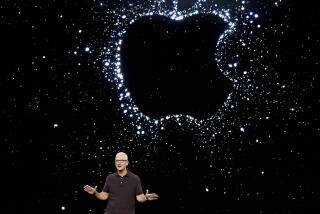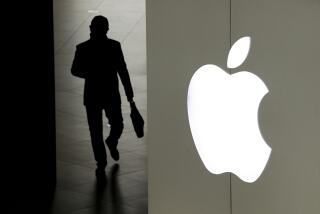Newcomers to Computers Try to Polish Apple
CUPERTINO, Calif. — Apple Computer Inc.’s new marketing director stood in his office last week praising the rainbow-colored apple logo that adorns the company’s products.
“It’s a terrific symbol. People love it. It’s soft. It’s warm. It’s friendly,” said Michael K. Lorelli, pretending to hold a large, round object. “I mean, don’tcha just want to wrap your arms around it?”
Consumers and educators indeed have been quick to embrace Apple’s products, giving the 8-year-old company a dominant position in personal computers at home and school. But in the business arena, where analysts say Apple must succeed if it is to maintain a leadership position in the market, executives have been less affectionate.
“Business is a different animal. There’s no doubt about it,” says Lorelli, who several months ago left a marketing job at Playtex to join Apple. Apple is a Fortune 500 company whose annual sales this year are expected to reach $2 billion. However, its inability to fend off International Business Machines on the business front has seriously eroded its market share. Analysts predict Apples will account for 24% of all mid-priced personal computers sold this year, or 15.5% of all dollars spent in that market, compared to a 31% share on a unit basis in 1980 that brought it a 35.6% dollar-share.
Computer analysts say the battle for the business dollars--65% of the market--will intensify next year, with sales of machines in the $1,000 to $5,000 range increasing 20% to $17 billion. They say Apple’s market share is likely to slip even more.
The question facing Apple after its trumpeted reorganization last spring and the resignation of co-founder Steven P. Jobs two weeks ago is whether a corps of marketing whizzes recruited from consumer giants like Pepsico, Playtex and Eastman Kodak can sell computer hardware as successfully as they have marketed soft drinks, bras and cameras. Moreover, can they do it during a computer industry slump? So far, Apple president and chief executive John Sculley--who Jobs enticed away from Pepsi in 1983 to bolster Apple’s marketing effort--has had as many failures as successes. With Jobs gone, responsibility for the company’s performance rests solely on Sculley’s shoulders.
Analysts say that good technology, abundant cash and a strong foothold among consumers and students ensures that Apple will remain a prominent computer maker. But they warn that unless the company boosts sales to small- and medium-sized companies and reverses a 5-year trend of steadily eroding market share, it likely will fall to a “second-tier” position within the desk-top computer industry 1988.
That, analysts say, will put Apple in the league of computer manufacturers like Compaq and Tandy/Radio Shack, which, though sound companies, are not powerful enough to play the leadership role that Apple has shared with IBM. More importantly, they say, that would undermine competition in all market segments and sap incentive for innovation.
“Right now it’s really IBM and Apple in first place,” says Richard H. Matlock, president of Infocorp, a market research firm that sits about a block from Apple’s headquarters in Silicon Valley. “Without competition, all personal computer users will suffer. Apple keeps IBM from getting sloppy--and from dictating terms to dealers.”
Recognizing the urgency of making a solid foray into business, Sculley reorganized the company in May and has since made an all-out effort to convince Wall Street that Apple is no longer a brash, arrogant upstart that champions counter-corporate culture, but a mature, market-driven company with consistent policies.
Maintain Spirit
Ever since the reorganization of the company kicked Jobs upstairs and away from day-to-day affairs, some analysts and former employees have wondered how Apple would maintain its “spirit.” Who, they ask, would inspire the company with fresh, innovative ideas? Apple executives scoff at the notion that there is any problem.
The executives insist Apple will continue to be “product-driven as well as market-driven.” But Apple clearly no longer intends to be the risk-taker it has been since Jobs and partner Stephen Wozniak created a machine that founded not only Apple, but the entire personal computer industry. Apple’s executives hint that the company will produce a steady stream of innovative machines, but that each will follow--rather than try to shape--the desires of users.
Last spring’s reorganization eventually led to the acrimonious departure of Jobs two weeks ago, when the 30-year-old multimillionaire angrily resigned as chairman, taking five top Apple employees with him to start a new venture. Apple fired back with a $5-million-plus lawsuit against Jobs. The drama brought more negative publicity to a company whose late product introductions and flip-flops in strategy in recent years made it appear confused and unreliable to many Wall Street analysts and executives.
Vote of Confidence
A $1 jump in Apple’s stock signaled that Wall Street approved the departure of Jobs, whose visionary but eccentric personality had inspired the company in its early years but, according to analysts, had lately hindered its growth. But the increase was a small vote of confidence in a stock that has fallen to the mid-teens from an all-time high of $62.62 in mid-1983. Although the price decline has been caused partly by a general downturn in all computer sales since then, it also reflects uncertainty over how Apple, especially under Sculley, would weather the current industry shakeout.
“Once you pull the tab on a Pepsi, the sales strategy analogy between consumer products and computers breaks down,” said David Fradin, analyst at Dataquest in San Jose, the heart of Silicon Valley. “You don’t need support services to drink Pepsi. Sculley needs to prove he understands the business mentality.”
Said Infocorp’s Matlock, “The big question for Apple is figuring out who they are. They are re-evaluating everything. I can’t praise them, I can’t fault them. But they’ll have to figure that out before they can execute a plan.”
To restore confidence, Sculley this summer vowed to analysts that Apple will improve relations with dealers, who sell most of Apple’s education and consumer machines but with whom the company traditionally has had difficulties. He also promised greater emphasis on geting new products delivered on time. More importantly, he said the company will reverse its long-time policy of pitting itself against IBM in advertisements as well as in the market. It’s a strategy that worked well with general consumers, analysts say, but failed among business buyers, who resented hearing that the purchase of IBMs, which dominate the corporate sector, is a mistake. Now the company will seek coexistence.
Detailed Blueprint
Apple executives said its board two weeks ago approved a detailed blueprint of the long-term strategy, but will not disclose specifics until this week, when the company begins to reveal the plan to its sales force and to dealers.
Sculley, however, has made at least one point clear: Apple will make its key business machine, the 18-month-old Macintosh, compatible with IBM products. The strategy--that Sculley just last year vowed the company would avoid--is a tacit admission that without IBM compatibility, even a company like Apple has little hope of surviving in the business market. Apple executives also hint that Apple will promote itself to business at least partly on the strength of the good reputation and strong sales that Apple II, its oldest product line and biggest money-maker, enjoys in the home and school market.
William V. Campbell, 44, executive vice president of marketing and sales who came to Apple from Eastman Kodak, concedes that Apple has made several “errors” in its business market strategy in the past.
Among them has been the introduction and then abandonment of two computers aimed at office users. The first was Apple III, introduced in the summer of 1980 and taken off the market last fall. The second was Lisa, which was introduced in 1983, renamed Macintosh XL and then withdrawn last April. Each computer sold tens of thousands of units, but not enough to satisfy Apple. Many executives who talked their companies into buying Apples were left embarrassed and angry.
Ruined Business Reputations
Said one former Apple employee, “More than 60% of personal computer sales are generated by word of mouth. When they withdrew Lisa and Apple III, they ruined the business reputations of thousands. Apple’s tactics have left a bad taste in corporate America’s mouth.”
Apple’s latest flip-flop in marketing strategy involves the long-awaited Macintosh. Although the Mac has not sold as well as Apple hoped, it has been successful enough that company executives say it won’t be yanked off the market. To help sales, Apple announced at a shareholders meeting in January the “Macintosh Office” marketing plan which was intended to provide an array of computer accessories, only to abandon the strategy in mid-summer for lack of enough products to support it.
Two weeks ago, Apple did introduce a long-promised hard-disk drive for the Macintosh, as well as several other new products for that machine and the Apple II. But two key products promised months ago are still unavailable: a file server to allow several Macintoshes to share data and an add-on circuit board that allows the machines to communicate with IBM personal computers.
To overcome prejudices that the delays and retrenchments produced, said Campbell, Apple’s top priority is “to establish our credibility in the business market. We need to get products people want out the door on time.”
Timely Development
The biggest product-related problem is not, however, selling accessories for existing machines but developing in timely fashion the next generation computer. Apple could be impeded in that process by the lawsuit it filed last week against Jobs. In the suit, Apple accuses Jobs of planning to use proprietary information about those products in his new company. To support such claims during a trial, Apple may have to reveal details of future products and other trade secrets.
The lawsuit may reinforce Apple’s brash image, but there are equally visible signs that indicate that attitudes at the company have changed.
Among them is a revamping of the company’s “event marketing” ad campaign, a strategy that ties commercials to major events, such as when Apple bought all the ad space in Newsweek’s special election issue last fall. Similarly, a commercial designed by Los Angeles-based Chiat/Day, which implied a link between IBM and Big Brother of George Orwell’s novel “1984,” ran only once, during the 1984 Super Bowl.
After a slump in 1983, Apple had a record year in 1984 and Sculley was named man of the year by Ad Age Magazine. But a TV spot for the 1985 Super Bowl that likened anyone who bought an IBM computer to a lemming falling off a cliff was widely condemned within the business community.
Don’t Like Mavericks
Industry analyst Esther Dyson, editor of Release 1.0., said: “Pitting themselves so strongly against IBM was a mistake. Businesses don’t like mavericks. They like pin-striped suits and white shirts.”
Apple’s continuing inability to appeal to executives is expected to show up as a 50% decline in earnings for the fourth quarter of its 1985 fiscal year, which ends Monday.
Its new ads, created by Chiat/Day to air during the special TV showing two weeks ago of Death of a Salesman, take a more traditional approach. They emphasize Apple II’s usefulness at home, school and work. “Apple should play on its strengths,” said analyst Fradin.
With that in mind, one of Sculley’s goals in reshuffling Apple was to move the company away from the upstart, rags-to-riches image so carefully cultivated over the years by its public relation’s firm, Regis McKenna. With Jobs gone (Wozniak left under similarly tense circumstance last February) the company is free to disassociate itself from personalities and folk heroes and to push itself instead into mainstream corporate America, Campbell said.
Long-Term Advantages
Analysts said there are other long-term advantages to the departure of Jobs, who had a reputation for being temperamental. Apple can now grapple with the broader question of how it will fit into a market that IBM and American Telephone & Telegraph are battling over and which ultimately is key to the business sector: The merger of the desk-top computer with the telephone to produce voice and data “work stations” for all size companies.
“Strategic alliances”--ranging from joint ventures to the development of new products all the way to “an out-and-out merger”--are more possible now that corporations “know they will not have to negotiate with Jobs,” Dyson said. “A lot more companies will be more willing to talk to Apple and Apple will be more willing to talk to them.”
Collaborations with other electronics giants, in fact, may be required if Apple is to meet its biggest challenge: Staying abreast of rapidly changing technology and applying it quickly to products businesses and consumers want. Apple executives say the company won’t consider a merger, but they do not rule out any other collaborations.
The changes Apple is undergoing would have taken place with or without Jobs’ departure, Apple executives say. His absence, however, marks an end to an era of homespun, often eccentric, “seat-of-the-pants” innovation so characteristic of Silicon Valley, says Jef Raskin, who was in charge of developing the Macintosh computer at Apple until he left in 1982 to start his own company.
Inappropriate Image
Wall Street, however, long ago realized the inappropriateness of Apple’s folksy image and wondered why Apple took so long to catch on. With sales of desk-top computers to small and medium-sized business “wide-open,” in the words of several analysts, Apple is polishing its image just in time.
In the last few months Jean-Louis Gassee, a mathematician by training and for many years in charge of Apple’s fast-growing French operations, was brought to the U.S. to head product development. Delbert W. Yocam, 41, a long-time Apple employee who rose through manufacturing to take charge of the Apple II, is now in charge of all the company’s engineering, manufacturing and distribution.
With these few exceptions, however, Apple’s executives are relative newcomers to the company and have little or no business background in computer development or sales.
Marketing chief Lorelli, wearing a blue-and-white striped Oxford shirt and tugging on a conservative cranberry-colored silk tie, insisted that Apple’s “friendly and informal” corporate culture never was defined by “blue jeans or T-shirts.”
“It has nothing to do with how you dress,” he said. “It’s a mental attitude and it’s as alive today as ever.” Pointing to a blue flag with a shark’s silhouette sewn into it that sits on his office shelf, he said, “That the emblem of our value-added resellers group. Now that division has plenty of spirit but because it wasn’t headed by Steve Jobs, it never made any headlines.”
APPLE COMPUTER AT A GLANCE In millions
1985* 1984 1983 1982 Revenue $1,905.5 $1,516.8 $982.8 $583.1 $334.8 Net income $45.8 $64.1 $76.7 $61.3 $39.4
*Estimated






